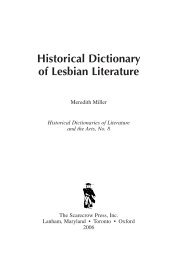Founded by Friends : the Quaker heritage of fifteen - Scarecrow Press
Founded by Friends : the Quaker heritage of fifteen - Scarecrow Press
Founded by Friends : the Quaker heritage of fifteen - Scarecrow Press
Create successful ePaper yourself
Turn your PDF publications into a flip-book with our unique Google optimized e-Paper software.
Haverford College 5<br />
In 1860, president-elect Lincoln, en route to Washington <strong>by</strong> train, appeared<br />
on <strong>the</strong> rear platform and bowed to <strong>the</strong> students assembled at <strong>the</strong><br />
Haverford station. Charles Roberts, class <strong>of</strong> 1864, who was at <strong>the</strong> station,<br />
reportedly rushed forward and requested <strong>the</strong> president’s signature. Not<br />
only did he receive a note from Lincoln, but this conquest also forged him<br />
into a lifelong collector <strong>of</strong> autograph letters. When Roberts died in 1902,<br />
he left <strong>the</strong> college 12,000 autograph letters (including <strong>the</strong> Lincoln note),<br />
encompassing <strong>the</strong> whole spectrum <strong>of</strong> human endeavor, from astronomy<br />
to zoology. This open-ended collection has continued to grow and today<br />
is comprised <strong>of</strong> more than 20,000 documents.<br />
SAMUEL J. GUMMERE (1811–1874),<br />
THE FIRST PRESIDENT, 1862–1874<br />
Samuel J. Gummere, son <strong>of</strong> Haverford’s second principal, John Gummere,<br />
was hired <strong>by</strong> Haverford in 1833 to teach ma<strong>the</strong>matics and natural philosophy,<br />
returning again in 1862 to take up <strong>the</strong> newly titled president’s position,<br />
created as part <strong>of</strong> Haverford’s transformation into a college. English<br />
literature was added to <strong>the</strong> curriculum in that year. In 1864, <strong>the</strong> board <strong>of</strong><br />
managers reaffirmed <strong>the</strong> need to conduct a school for <strong>the</strong> benefit <strong>of</strong> members<br />
<strong>of</strong> <strong>the</strong> Society <strong>of</strong> <strong>Friends</strong>.<br />
In 1861, <strong>the</strong> Civil War had reduced <strong>the</strong> total number <strong>of</strong> students to fifty;<br />
<strong>by</strong> 1863–1864, it had risen to sixty-one, and <strong>the</strong>re were eleven graduating<br />
students—practically <strong>the</strong> largest class in <strong>the</strong> college’s history. The war<br />
proved a particularly difficult time for <strong>Quaker</strong>s, pitting <strong>the</strong> peace testimony<br />
against <strong>the</strong> antislavery principle. Some Haverfordians felt compelled<br />
to fight. Among <strong>the</strong>m were Brigadier General Isaac Wistar, Colonel<br />
Norwood Penrose Hallowell, and o<strong>the</strong>rs, including James Parnell Jones,<br />
class <strong>of</strong> 1855. Jones was <strong>the</strong> son <strong>of</strong> Eli and Sybil Jones and cousin to Rufus<br />
M. Jones, who would later become a pr<strong>of</strong>essor <strong>of</strong> philosophy. Haverford’s<br />
Jones Family Papers manuscript collection includes (among o<strong>the</strong>rs) two<br />
letters from James Parnell Jones, one from “10th mo 31st [18]52,” in which<br />
he told his parents that discussion <strong>of</strong> slavery was not allowed at Haverford.<br />
In <strong>the</strong> second, dated September 25, 1861, Jones told his fa<strong>the</strong>r that he<br />
believed wholeheartedly in <strong>the</strong> union’s cause and hoped that his parents<br />
would see his viewpoint. Jones rose to <strong>the</strong> rank <strong>of</strong> major and was killed<br />
<strong>by</strong> a stray bullet in 1864.<br />
In 1870, faculty members considered admitting women and agreed<br />
unanimously on <strong>the</strong> benefits <strong>of</strong> such a move. The opening <strong>of</strong> Swarthmore<br />
College in 1864, a “Hicksite” coed institution, may have influenced <strong>the</strong>ir<br />
decision. Haverford’s board <strong>of</strong> managers didn’t agree, and <strong>the</strong> college remained<br />
single sex.
















